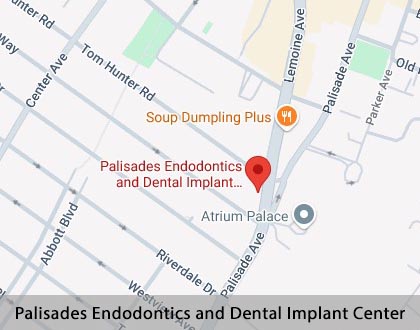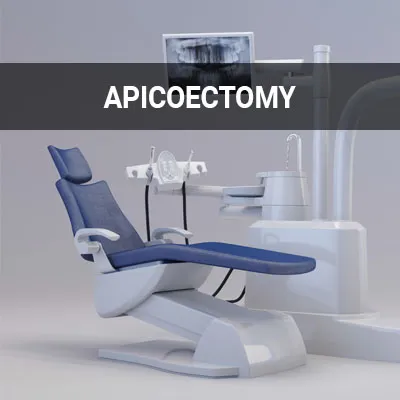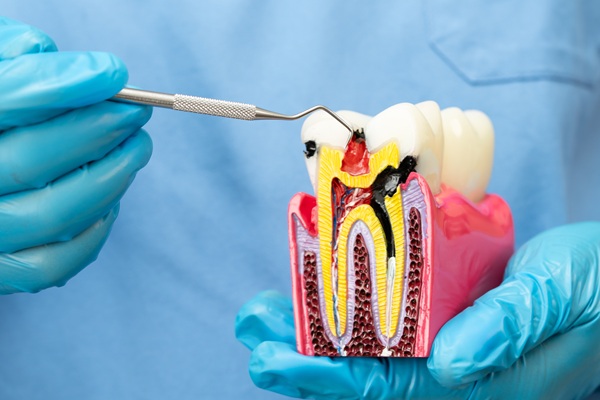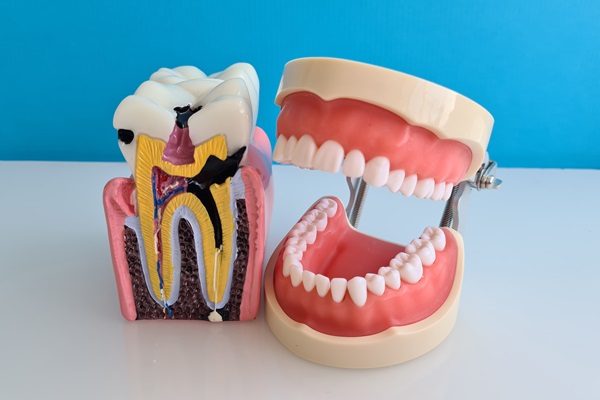Root Canal Treatment Fort Lee, NJ
If you are experiencing severe and persistent tooth pain, root canal treatment may be necessary to remove the infected pulp. A root canal can save a person's natural tooth from extraction and relieve dental pain. This specialized treatment is a safe and effective way to improve your oral and overall health.
Root canal treatment is available at Palisades Endodontics and Dental Implant Center in Fort Lee and the surrounding area. Our team can help determine whether a root canal can save your tooth. Call us today at (201) 877-1190 to learn more about our services or schedule an appointment.
About Root Canal Treatment
Root canal treatment is a common type of endodontic treatment that saves infected teeth. Approximately 15 million root canals are performed in the United States each year. Endodontic treatment deals with the inside of the tooth, including the dental pulp. The dental pulp is the soft tissue that consists of blood vessels, connective tissues, and nerves. It extends from the tooth's crown to the tips of the roots, where it connects to the tissues that surround the root. The dental pulp is important for a tooth's growth and development. However, once the tooth is fully mature, it can survive and receive the nutrients it needs without the pulp.
When the dental pulp becomes inflamed or infected, a root canal is necessary to save a person's natural tooth from extraction. During a root canal procedure, we will remove the infected or inflamed pulp from the pulp chamber, then refill the root canal to prevent further damage. While a regular dentist can also provide patients with root canals, endodontists have the specialized education, training, and experience to perform this procedure. Endodontists routinely perform root canals and specialize in treating complex causes of tooth pain.
“The infected or inflamed pulp is removed from the pulp chamber and root canals during a root canal procedure and is refilled to prevent further damage.”
Root Canal Benefits
If a person has infected or damaged tooth pulp, there are many benefits to receiving a root canal. A root canal can remove the bacteria and damaged tissue from a patient's root canals and save the tooth from extraction. Saving the tooth from extraction allows patients to keep their natural smiles so they can continue to function properly and maintain their overall health. A root canal to save a tooth is more beneficial than extracting a tooth because nothing looks, feels, or functions as well as a natural tooth. Root canal treatment is not painful and can prevent patients from experiencing painful symptoms resulting from an inflamed or infected pulp. The root canal procedure will help to relieve pain, allowing patients to achieve lasting relief. Ignoring the problem will only make the situation worse until the tooth damage becomes so severe that an extraction is necessary.
If a tooth is causing severe and persistent pain due to damaged dental pulp, speak to an endodontist about root canal treatment before considering tooth extraction. While people may believe extracting a tooth is easier and more cost-effective, this is untrue. A missing tooth can cause the surrounding teeth to shift out of their natural place, affecting their ability to function properly, the appearance of one's teeth, and even one's facial structure. Additionally, in many cases, tooth extraction is more painful than a tooth extraction. Removing a tooth will also require people to get a replacement tooth and additional dental visits that can add up quickly. Root canal treatment offers patients the ability to save their natural teeth and improve current and future dental health.
“A root canal to save a tooth is more beneficial than extracting a tooth because nothing looks, feels, or functions as well as a natural tooth.”
Reasons to Have a Root Canal
Root canal treatment is necessary when the dental pulp inside the root canal gets infected or inflamed. The infected or inflamed dental pulp may occur due to trauma or damage from repeated dental procedures, injury, or cracks or chips in a tooth. Without treatment, the pulp inflammation or infection can lead to severe pain or abscess. An abscess is a pocket of pus that happens when bacteria invade the dental pulp, which contains blood vessels, connective tissue, and nerves. An abscess requires prompt treatment to prevent serious and sometimes life-threatening complications. Some signs that a person may require a root canal include:
- Chipped or cracked tooth: People that have a chipped or cracked tooth may also need root canal treatment if bacteria invade the tooth and cause inflammation and infection. This type of tooth damage can also damage the nerves and cause pain and sensitivity.
- Loose tooth: An infected tooth may also feel looser. The resulting acidic products from nerve death can damage the bone around the root of a damaged tooth and allow it to move.
- Persistent pain: Tooth pain may persist without waning or disappear and return. People may feel pain deep in the bone of their teeth or in their face, jaw, or surrounding teeth.
- Sensitivity to heat or cold: People may experience tooth sensitivity when eating or drinking hot or cold foods or beverages. This feeling may indicate that the blood vessels or nerves in a tooth are damaged or infected.
- Swollen gums: If a person has swollen gums next to a painful tooth, it can also be a sign that a root canal may be necessary. Dead pulp tissue can create acidic waste that causes swelling outside a tooth’s root tip.
- Tooth discoloration: Infected tooth pulp can also cause a tooth to become discolored. Damaged internal tissue can result in the tooth changing to black or grey color.
- Tooth pain when eating: A tooth that is sensitive when touched may indicate nerve damage or decay. Waste products from the dying dental pulp can irritate the ligament around the tooth’s root tip, which causes pain from biting pressure.
The only way to truly know whether a root canal can help is by seeking professional care. However, knowing the signs to watch out for can allow people to seek prompt endodontic treatment. The earlier patients receive treatment, the better their outcomes will be.
“Infected or inflamed dental pulp may occur due to trauma or damage from repeated dental procedures, injury, or cracks or chips in a tooth.”
Check out what others are saying about our dental services on Yelp: Root Canal Treatment in Fort Lee, NJ
The Treatment Process
The first step of the root canal treatment process is examining the tooth to understand the problem and determine the appropriate treatment plan. We will examine the inside of a patient's mouth and take X-rays to get a better view of their pulp chamber. Before we can begin the root canal, we will administer local anesthetics to numb the treatment site and help patients remain relaxed and comfortable. Dental dam placement will also occur to isolate the treatment site and prevent saliva, bacteria, or debris from contaminating the area.
Afterward, we will drill into the tooth's crown to get access to the root canal. Next, specialized dental instruments go into the dental pulp chamber and root canals to clean out the inflamed or infected pulp. Once the damaged pulp is removed, we will clean the remaining space to make room for a filling that replaced the pulp. The filling will consist of a suitable biocompatible material. After an adhesive dental cement will seal the root canal and prevent future infections from damaging the tooth. Eventually, patients will need a crown placed over their tooth to protect it long-term.
“Next, specialized dental instruments go into the dental pulp chamber and root canals to clean out the inflamed or infected pulp.”
Questions Answered on This Page
Q. What is root canal treatment?
Q. What are the benefits of receiving root canal treatment?
Q. What are some signs that a root canal may be necessary?
Q. What is the root canal treatment process?
Q. What aftercare instructions should patients follow after root canal treatment?
People Also Ask
Q. Why do endodontists perform root canals?
Q. How does an endodontist save teeth?
Q. What are the symptoms of an abscessed tooth?
Q. What kind of procedure is an apicoectomy?
Root Canal Aftercare
It is normal for a treated tooth to feel sensitive after root canal treatment. Once the numbing sensation from local anesthetics wears off a few hours after the procedure, patients will begin to feel some tenderness and mild jaw soreness from keeping their mouths open for an extended period. This discomfort is temporary and should only last for a few days. Patients should wait until the numbness in their mouths completely disappears before eating to avoid biting their cheek or tongue. Patients can manage their discomfort using over-the-counter or prescription pain medication. The treated tooth may continue to feel different than other teeth for some time after the procedure. However, patients who experience severe pain or pressure that persists for more than a few days should contact our office.
Following all aftercare instructions is crucial for a smooth healing process. Patients should avoid chewing or biting down on treated teeth until the restoration process is complete following a root canal. It is still important to brush and floss every day to keep the mouth clean and avoid infection. Even after the root canal procedure is done and patients receive a restoration to protect and support the treated tooth, it is still important to properly care for teeth. This includes brushing, flossing, and scheduling regular dental check-ups and cleanings. Proper oral hygiene and maintenance can help a treated and restored tooth last for a lifetime. However, if pain or swelling occurs in the future, be sure to contact our team. In some cases, retreatment is necessary to save a tooth.
“Following all aftercare instructions is crucial for a smooth healing process.”
Frequently Asked Questions
Q. What happens if my root canal fails?
A. While a majority of root canals are successful, they can fail for several reasons. For example, a root canal can fail due to insufficient canal cleaning, crown or sealant breakdown, or anything that allows the root to become infected. If a root canal fails, several options are available, such as a root canal retreatment or an apicoectomy.
Q. What can I do to avoid having another root canal in the future?
A. Maintaining proper oral hygiene is a great way to avoid tooth decay and prevent the need for another root canal in the future. We also recommend avoiding sugary and acidic foods and beverages to prevent decay. Patients should also schedule regular dental check-ups.
Q. Do I still need a root canal if my tooth is not bothering me?
A. Some patients who need a root canal may experience no pain or pain that goes away on its own. However, even a tooth that is not painful may still have an infection that requires endodontic treatment. Our team can examine a patient's tooth to determine whether root canal treatment is necessary.
Q. How long does it take to receive root canal treatment?
A. The length of time it takes to receive a root canal depends on the severity of the situation, the type of tooth receiving treatment, the number of root canals needed, and whether treatment occurs over one or two appointments. If a patient receives treatment over two appointments, the first session will involve cleaning and shaping the inner tooth tissue. The second session may occur one to three weeks following the first one and involves filling and sealing the inner canal. A single root canal appointment may last between 90 minutes to three hours.
Q. Will a root canal weaken my tooth?
A. Yes, root canal treatment can weaken a tooth's overall structure since it involves removing the inner section. However, the treated tooth will receive a dental restoration like an onlay or crown to reinforce the structure. Our team will provide patients with the treatment to ensure tooth strength following root canal treatment.
Start Feeling Better – Visit Us Today
By visiting us as soon as possible, our team can help get you the professional treatment you need. Instead of waiting around and allowing the symptoms to get worse, we can provide you with treatment options.
Definitions
Call Us Today
Root canal treatment can remove the infected or inflamed dental pulp and save a natural tooth from extraction. Our team at Palisades Endodontics and Dental Implant Center can help resolve your dental pain and restore your mouth's functioning. Call us today at 201-877-1190 to learn more about our services or schedule an appointment.
Helpful Related Links
- American Association of Endodontics. Why See An Endodontist. 2024
- American Dental Association. Root Canals. 2024
- Byte. 7 Tips for Root Canal Aftercare. 2024
- Cleveland Clinic. What is pulpitis? 2024
- Healthline. Tooth Anatomy. 2024
- Humana. How to treat sore or swollen gums. 2024
- Mayo Clinic. Root canal treatment. 2024
- WebMD. What Is an Abscessed Tooth? 2024
About our business and website security
- Palisades Endodontics and Dental Implant Center was established in 1997.
- We accept the following payment methods: American Express, Cash, Check, Discover, MasterCard, and Visa
- We serve patients from the following counties: Bergen County
- We serve patients from the following cities: Fort Lee, Palisades Park, Leonia, Edgewater, Ridgefield, Englewood, Tenafly, and Alpine
- National Provider Identifier Database (1124100102). View NPI Registry Information
- Norton Safe Web. View Details
- Trend Micro Site Safety Center. View Details
Back to top of Root Canal Treatment










